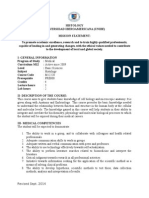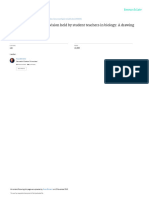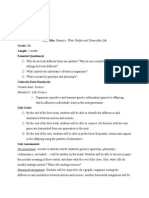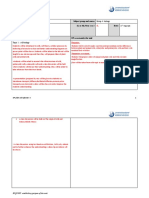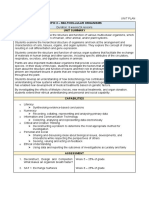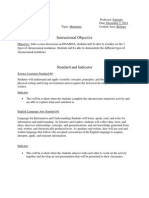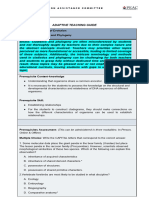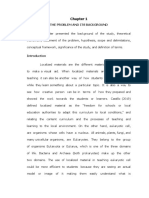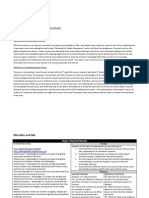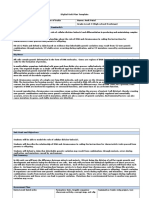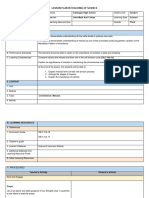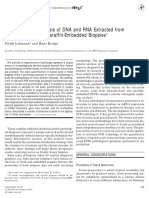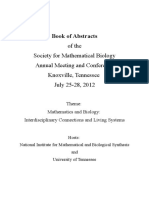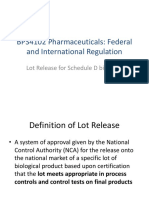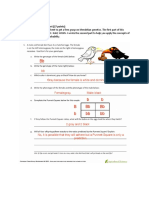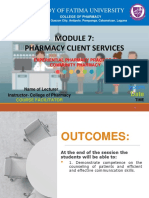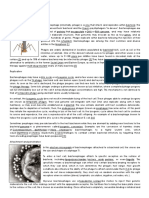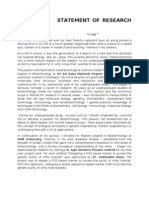Example of Biology Unit Plan Using Planner 2
Example of Biology Unit Plan Using Planner 2
Uploaded by
Dhara LeversCopyright:
Available Formats
Example of Biology Unit Plan Using Planner 2
Example of Biology Unit Plan Using Planner 2
Uploaded by
Dhara LeversOriginal Title
Copyright
Available Formats
Share this document
Did you find this document useful?
Is this content inappropriate?
Copyright:
Available Formats
Example of Biology Unit Plan Using Planner 2
Example of Biology Unit Plan Using Planner 2
Uploaded by
Dhara LeversCopyright:
Available Formats
DP unit planner 2 (MYP aligned)
Teacher(s) Alejandro Franco Subject group and course Group 4, Biology
Course part Meiosis, Karyograms and Karyotyping SL or HL/Year 1 or 2 HL/1 Dates April 2013
and topic
Semester 2
Unit description and texts DP assessment(s) for unit
Paper 1, Multiple choice
A detailed look at meiosis, variation and the relation with sexual
reproduction. Topic 4.2 for both SL and HL and 10.1 for HL, in Paper 2, Data based, short and extended response
preparation for papers 1 and 2. Biology course companion (Oxford) and PSOW 4, Computer models and simulations, use of databases
Higher Level Biology (Pearson) textbooks
INQUIRY: establishing the purpose of the unit
Transfer goals
List here one to three big, overarching, long-term goals for this unit. Transfer goals are the major goals that ask students to “transfer”, or apply, their
knowledge, skills, and concepts at the end of the unit under new/different circumstances, and on their own without scaffolding from the teacher.
1. Students will understand how genes combine to provide new combinations that are different from both parents (variation), how this is a
consequence of cell division, and how these combinations reflect the effects of the environment.
2. Students will demonstrate their understanding by writing organized, precisely worded essays and short answers that use support from annotated
diagrams of the different stages of meiosis and its relationship with sexual reproduction, as well as interpreting and analysing karyograms.
3. Students will demonstrate their understanding of the effects of having access to the information in a person’s genetic makeup by effectively
researching, discussing and debating the topics of abortion, gender selection, genetic screening and chromosomal abnormalities.
DP unit planner 2 (MYP aligned) 1
Essential understandings
List here the key content/skills/concepts that students will know/have at the end of the unit.
Students will know the following content:
1. Students will be able to define what a homologous chromosome is, as well as distinguish between them and sister chromatids.
2. Students will be able to state that meiosis is a reduction division of a diploid nucleus to form haploid nuclei.
3. Student will be able to state Mendel’s Law of Independent Assortment.
4. Students will be able to state that a karyogram shows the chromosomes of an organism in homologous pairs of decreasing length.
5. Students will be able to distinguish between meiosis and mitosis.
6. Students will be able to outline the stages of meiosis and describe the behaviour of chromosomes in these.
7. Students will be able to outline the relationship between crossing over, homologous chromosomes, random orientation and variation.
8. Students will be able to describe the methods of obtaining cells for making a karyogram.
9. Students will be able to explain the relationship between karyotypes, non-disjunction and meiosis.
Students will develop the following skills:
10. Students will be able to identify the stages of meiosis by looking at cells through a microscope.
11. Students will be able to identify the stages of meiosis by staining tissues containing germ-line cells.
12. Students will be able to identify the stages of meiosis when looking at diagrams.
13. Students will be able to make annotated diagrams of the stages of meiosis.
14. Students will explain and analyse a karyogram.
15. Students will be able to write about the relationship between meiosis, variation, sexual reproduction and evolution.
Students will grasp the following concepts:
16. Certain beliefs remain in a culture for long periods of time.
17. Gender discrimination and pre-natal screening can lead to increased rates of abortion.
18. Social stigmatization has an effect on family life.
19. Scientific discoveries require time, meticulous observations and acceptance by the scientific community.
20. There are differences between laws and theories in science.
Inquiry questions
DP unit planner 2 (MYP aligned) 2
List here the understandings above written in question form, preferably as ones that inspire students to answer them.
Content-based:
1. What is meiosis and how does it happen?
2. When and where does meiosis happen?
3. What are the differences between a homologous chromosome and sister chromatids?
4. What are the differences between these and chromatin?
5. How are Mendel’s laws associated with meiosis?
6. What is a karyogram and what does it show?
7. What is the difference between a karyogram and a karyotype?
8. What is the difference between meiosis and mitosis?
9. What are the stages of meiosis? What happens to the chromosomes in these stages?
10. What is the relationship between crossing over, homologous chromosomes, random orientation and variation?
11. What happens if meiosis goes wrong? How do you know?
12. What is the relationship between karyotypes, non-disjunction and meiosis?
Skills-based:
13. What does a cell undergoing meiosis look like through a microscope?
14. How do diagrams of cells undergoing meiosis look like?
15. How do you obtain cells for making a karyogram?
16. How do you analyse a karyogram?
17. How can you explain the relationship between meiosis, variation, sexual reproduction and evolution?
Concepts-based:
18. What role do biological and genetic factors play in someone’s decision to undergo an abortion?
19. Who should have access to the genetic information of a patient?
20. Who should control what can and can’t be done with the genetic information of an individual?
21. What makes religious/cultural beliefs so difficult to change? When is it acceptable that they don’t?
22. If you are aware of the risks of having a child, should you still decide to?
23. Why are scientists resilient to change? Why are scientific “truths” difficult to change?
24. Can a theory become a law?
DP unit planner 2 (MYP aligned) 3
ACTION: teaching and learning through inquiry
Content/skills/concepts Learning process
Cut and paste or draw from the essential understandings listed above in “Inquiry”. Check the boxes for any pedagogical approaches used during
the unit. Aim for a variety of approaches to help facilitate
learning.
Students will know the following content: Learning experiences and strategies/planning for self-supporting
learning:
1. Students will be able to define what a homologous chromosome is, as well as
distinguish between them and sister chromatids. Lecture
2. Students will be able to state that meiosis is a reduction division of a diploid Socratic seminar
nucleus to form haploid nuclei.
3. Students will be able to state Mendel’s Law of Independent Assortment. Small group/pair work
4. Students will be able to state that a karyogram shows the chromosomes of an Powerpoint lecture/notes
organism in homologous pairs of decreasing length.
5. Students will be able to distinguish between meiosis and mitosis. Individual presentations
6. Students will be able to outline the stages of meiosis and describe the behaviour Group presentations
of chromosomes in these.
Student lecture/leading
7. Students will be able to outline the relationship between crossing over,
homologous chromosomes, random orientation and variation. Interdisciplinary learning
8. Students will be able to describe the methods of obtaining cells for making a Details:
karyogram.
9. Students will be able to explain the relationship between karyotypes, non- Other/s:
disjunction and meiosis. Online activity and research.
Class discussion.
Students will develop the following skills:
Formative assessment:
10. Students will be able to identify the stages of meiosis by looking at cells through a
microscope. 1. Written description of meiosis
11. Students will be able to identify the stages of meiosis by staining tissues 2. Diagram and flow chart of stages of meiosis
DP unit planner 2 (MYP aligned) 4
containing germ-line cells. 3. Meiosis online activity
12. Students will be able to identify the stages of meiosis when looking at diagrams. 4. Looking at meiosis through the microscope
13. Students will be able to make annotated diagrams of the stages of meiosis. 5. Onion toot tip squash lab
14. Students will explain and analyse a karyogram. 6. Annotation of diagram exercise based on images
15. Students will be able to write about the relationship between meiosis, variation, obtained from the internet
sexual reproduction and evolution. 7. Online research and class discussion
8. Chromosomal abnormality research and discussion
Students will grasp the following concepts:
9. Practice questions from past papers
16. Certain beliefs remain in a culture for long periods of time.
17. Gender discrimination and pre-natal screening can lead to increased rates of
abortion.
Summative assessment:
18. Social stigmatization has an effect on family life.
19. Scientific discoveries require time, meticulous observations and acceptance by 1. Meiosis quizzes
the scientific community. 2. Diagram comparison of stages of mitosis and meiosis
20. There are differences between laws and theories in science. 3. Semester exam
4. Essay on the relationship between meiosis, variation,
sexual reproduction and evolution
5. Group presentation
6. Karyotyping activity online
Differentiation:
For more information on the IB’s approach to differentiation,
please see the guide.
Affirm identity—build self-esteem
Value prior knowledge
DP unit planner 2 (MYP aligned) 5
Scaffold learning
Extend learning
Details:
Approaches to learning (ATL)
Check the boxes for any explicit approaches to learning connections made during the unit. For more information on ATL, please see the guide.
Thinking
Social
Communication
Self-management
Research
Details: Individual and group research and presentations
DP unit planner 2 (MYP aligned) 6
Language and learning TOK connections CAS connections
Check the boxes for any explicit language and Check the boxes for any explicit TOK connections Check the boxes for any explicit CAS connections.
learning connections made during the unit. For made during the unit. If you check any of the boxes, provide a brief
more information on the IB’s approach to note in the “details” section explaining how
language and learning, please see the guide. students engaged in CAS for this unit.
Activating background knowledge Personal and shared knowledge Creativity
Scaffolding for new learning Ways of knowing Activity
Acquisition of new learning through practice Areas of knowledge Service
Demonstrating proficiency The knowledge framework Details:
Details: annotation of diagrams, quizzes and Details: Natural sciences
semester exam
Resources
List and attach (if applicable) any resources used in this unit.
Pearson Baccalaureate: Higher Level Biology (and weblinks)
Oxford: Biology Course Companion
Meiosis and Mutations presentations (see links)
Karyotyping activity: http://www.biology.arizona.edu/human_bio/activities/karyotyping/karyotyping.html
Gene linkage: http://www.slideshare.net/gurustip/dihybrid-crosses-gene-linkage-and-recombination.html
DP unit planner 2 (MYP aligned) 7
REFLECTION: Considering the planning, process and impact of the inquiry
What worked well What didn’t work well Notes/changes/suggestions:
Comparison diagrams between mitosis and Onion root tip squash was long and difficult Taking some time to explain gene linkage to
meiosis, students were able to understand for manipulation. Few clear results were reinforce crossing-over, or alternatively not
and visualize the differences in the two obtained. mentioning gene linkage at all in this module.
processes. A connection with gene linkage should have Clear explanation of gametogenesis in men
Online activities were engaging, fun, been made here to clarify crossing over. and women.
informative and challenging. The discussion on the differences between A good discussion/debate on ethical
Meiosis in cells through a lab was challenging meiosis in men and woman was confusing for implications of karyotyping can be done,
and helped students see that it is not always some students who struggled with the idea of associated with abortion and gender
quite clear or easy to identify the cells. “one” cell being produced. selection.
Chromosomal abnormality research, students’ Some students struggled to separate gene Carefully look at which ATL can be used and
interest and understanding of meiosis mutation from chromosomal mutations. reinforce these more in the struggling
increased as it made it more real for them; it Misconception that not all organisms have 23 students.
also brought questions about male and female pairs of chromosomes, even though this was
processes and discussions about age and reinforced throughout, in the semester exam
reproduction. multiple choice question; this question was
Reinforcement of the differences between wrong by more than one student.
homologous chromosomes and sister Comparison of sampling techniques was a
chromatids, in the diagram and the flow chart, little vague, more focus or maybe in class
helped students understand the different rather than homework assignment.
stages of the process more clearly.
Essay writing was very productive, though
students do not really like to write long essays
in class. The research and practice of putting
things in paragraph form reinforced their
knowledge, helped them clarify concepts and
practice their communication skills to ensure
meaning was being passed on.
Use of practice problems and past paper
questions helped them get familiar with
examiner expectations and standards.
Transfer goals
DP unit planner 2 (MYP aligned) 8
List the transfer goals from the beginning of this unit planner.
1. Students will understand how genes combine to provide new combinations that are different from both parents (variation), how this is
a consequence of cell division, and how these combinations reflect the effects of the environment.
2. Students will demonstrate their understanding by communicating in developed, organized and precisely worded commentaries that
use support from annotated diagrams of the different stages of meiosis and its relationship with sexual reproduction, as well as
interpreting and analysing karyograms.
3. Students will demonstrate their understanding of the effects of having access to the information in a person’s genetic makeup by
conducting research and discussing and debating about the topics of abortion, gender selection, genetic screening and chromosomal
abnormalities.
Transfer reflection
How successful were the students in achieving the transfer goals by the end of the unit?
Both students and I felt that this was a good experience, and that it was useful. Students felt well prepared, as they had practised these skills
with the exercises in class and the data questions, as well as the online activities.
Students were capable of achieving transfer goals 1 and 2, though struggled with transfer goal 3 in that they struggled to stay logical and
empirical and not get emotional; this is a huge area ripe for improvement (debate, Socratic seminar, etc.) that would make connections with
other areas clearer.
Overall, I feel that the transfer goals were met and that the assessments, both formative and summative, were adequately designed to
facilitate transfer in these areas.
DP unit planner 2 (MYP aligned) 9
You might also like
- Example of Biology Unit Plan Using Planner 3Document10 pagesExample of Biology Unit Plan Using Planner 3api-33948704092% (12)
- Grade 8 Science Unit Plan Sample Lesson PlansDocument14 pagesGrade 8 Science Unit Plan Sample Lesson Plansapi-553147978100% (1)
- Classification WorksheetsDocument9 pagesClassification WorksheetsAnisah MahmudahNo ratings yet
- Example of Biology Unit Plan Using Planner 3Document10 pagesExample of Biology Unit Plan Using Planner 3Michelle PlunkettNo ratings yet
- Law of Segregation-Meiosis Lesson PlanDocument3 pagesLaw of Segregation-Meiosis Lesson PlanNhoj Kram AlitnacnosallivNo ratings yet
- Karyotyping Lesson Plan - Biology 30sDocument3 pagesKaryotyping Lesson Plan - Biology 30sapi-395453264No ratings yet
- LE Q2 Science-7 Week-5Document34 pagesLE Q2 Science-7 Week-5charmescalada20No ratings yet
- 1 BIO LP 5 EditedDocument5 pages1 BIO LP 5 EditedRosemarie Soldevilla LanderoNo ratings yet
- MD AnatomyDocument16 pagesMD AnatomyJaydenNo ratings yet
- Learning ObjectivesDocument29 pagesLearning Objectiveswendelyn.buenaNo ratings yet
- Unit Plan Heredity and GeneticsDocument6 pagesUnit Plan Heredity and GeneticsAutumnNo ratings yet
- Histology Syllabus Jan. - April 2015 UNIBEDocument33 pagesHistology Syllabus Jan. - April 2015 UNIBECristina A Rodriguez100% (1)
- Stages of MeiosisDocument5 pagesStages of MeiosisShang KirsteinNo ratings yet
- Teacher(s) Sreekala.K.P Subject Group and Course Course Part and Topic SL & HL/Year 2 Dates 15Document9 pagesTeacher(s) Sreekala.K.P Subject Group and Course Course Part and Topic SL & HL/Year 2 Dates 15Nana Refaye100% (1)
- Bruton-Annotated Lesson PlanDocument22 pagesBruton-Annotated Lesson Planapi-489727615No ratings yet
- Science Unit Plan: Mendelian Genetics and Genetic TechnologiesDocument44 pagesScience Unit Plan: Mendelian Genetics and Genetic Technologiesebc07No ratings yet
- Week of 1 4 21 - Science Long Form W SP 21Document8 pagesWeek of 1 4 21 - Science Long Form W SP 21api-544875454No ratings yet
- Grade 7Document6 pagesGrade 7Pat TrickNo ratings yet
- Lesson Plan 01 BIO (Grade 9)Document78 pagesLesson Plan 01 BIO (Grade 9)حزیفہ بھٹیNo ratings yet
- MYP Unit Plan 4Document5 pagesMYP Unit Plan 4ashokNo ratings yet
- Investigation 1Document9 pagesInvestigation 1api-165501247No ratings yet
- Misconceptions of Cell Division Held by Student Teachers in Biology: A Drawing AnalysisDocument14 pagesMisconceptions of Cell Division Held by Student Teachers in Biology: A Drawing AnalysisAlessandra TalaNo ratings yet
- Unit PlanDocument4 pagesUnit Planapi-301973984No ratings yet
- DP Pilot Unit Planner 3Document10 pagesDP Pilot Unit Planner 3Nana RefayeNo ratings yet
- Pka Lesson Plan Modern GeneticsDocument17 pagesPka Lesson Plan Modern Geneticsapi-356227663No ratings yet
- Genetics Lesson Plan RevisionDocument3 pagesGenetics Lesson Plan RevisionJaqueline Kaye Tivoli KalawNo ratings yet
- Course Syllabus BIOL 1413 - General Zoology: Revised 2013-01-11Document11 pagesCourse Syllabus BIOL 1413 - General Zoology: Revised 2013-01-11Mark ElbenNo ratings yet
- Interacting Systems That Provide Specific Functions Within Multicellular OrganismsDocument6 pagesInteracting Systems That Provide Specific Functions Within Multicellular Organismsapi-737778459No ratings yet
- Course Design - BiologyDocument16 pagesCourse Design - Biologyapi-639779884No ratings yet
- Year 11 Biology Unit PlanDocument6 pagesYear 11 Biology Unit Planapi-632307358No ratings yet
- Program StandardDocument33 pagesProgram StandardnzNo ratings yet
- Uraian (Essay) PDFDocument13 pagesUraian (Essay) PDFListya DevinaNo ratings yet
- Ngss Dup Goals Objectives and Assessments - TemplateDocument5 pagesNgss Dup Goals Objectives and Assessments - Templateapi-549667596No ratings yet
- Genetics - Meiosis: 1.0 SummaryDocument10 pagesGenetics - Meiosis: 1.0 SummaryAbubakr Hassan AhmadNo ratings yet
- MD Human Anatomy (Revised)Document25 pagesMD Human Anatomy (Revised)VJNo ratings yet
- Biology 1010 General ObjectivesDocument2 pagesBiology 1010 General Objectivesapi-241247043No ratings yet
- Teachers InformationDocument3 pagesTeachers InformationAnge Joey LauNo ratings yet
- BIO SCI OsmosisDocument10 pagesBIO SCI OsmosisJoy FernandezNo ratings yet
- Lesson Plan Mitosis and MeiosisDocument9 pagesLesson Plan Mitosis and MeiosiscsamarinaNo ratings yet
- Meiosis Lesson Tuesday 2 4Document6 pagesMeiosis Lesson Tuesday 2 4api-506872434No ratings yet
- M2 Lesson2 - SignificanceOfMeiosisInMaintainingTheChromosomeNumber 2Document7 pagesM2 Lesson2 - SignificanceOfMeiosisInMaintainingTheChromosomeNumber 2Shang KirsteinNo ratings yet
- DLL On Changes in Chromosome NumberDocument4 pagesDLL On Changes in Chromosome NumberGu Jun Pyo100% (1)
- Mutation LessonDocument5 pagesMutation Lessonapi-242797673No ratings yet
- ATG-Cladistics and PhylogenyDocument13 pagesATG-Cladistics and PhylogenyJenedil PauloNo ratings yet
- AaaaaaaaaaaaaaaaaaaaaaaaaaaaaaDocument26 pagesAaaaaaaaaaaaaaaaaaaaaaaaaaaaaaGlen Mark MacarioNo ratings yet
- Cell Organelles 10 Day Lesson PlanDocument14 pagesCell Organelles 10 Day Lesson PlanRandi Lines100% (2)
- Ubd Unit Planning Template - 325Document12 pagesUbd Unit Planning Template - 325api-401079332No ratings yet
- STEM - BIO11 12 Id F 7Document4 pagesSTEM - BIO11 12 Id F 7Michael Conan MaglaqueNo ratings yet
- General Biology I M4Document24 pagesGeneral Biology I M4Anjhiene CambaNo ratings yet
- Helen Haskell Unit Plan: Microbes and Me 7 Grade Life ScienceDocument15 pagesHelen Haskell Unit Plan: Microbes and Me 7 Grade Life SciencesarlouisesmithNo ratings yet
- Example Middle Science PlanningDocument8 pagesExample Middle Science PlanningtdelffsNo ratings yet
- Student Learning Analysis ChromosomesDocument9 pagesStudent Learning Analysis Chromosomesapi-711049973No ratings yet
- Final StudyDocument45 pagesFinal StudyRheyl Mar NarisNo ratings yet
- GenBio1 ATG Week4-6Document8 pagesGenBio1 ATG Week4-6Aran Jake BarramedaNo ratings yet
- Hhaskell - Microbes and Me Unit PlanDocument8 pagesHhaskell - Microbes and Me Unit Planapi-252656034No ratings yet
- Digital Unit Plan 304Document4 pagesDigital Unit Plan 304api-300436413No ratings yet
- 4-5-Lesson Plan - Cell Division - MeiosisDocument11 pages4-5-Lesson Plan - Cell Division - MeiosisJohn Mark CelosaNo ratings yet
- UbD PalnDocument19 pagesUbD PalnMaria Anwar/TCHR/BPJCNo ratings yet
- MYP Unit Planner: Stage 1: Integrate Significant Concept, Area of Interaction and Unit QuestionDocument6 pagesMYP Unit Planner: Stage 1: Integrate Significant Concept, Area of Interaction and Unit QuestionAlib BudiyantoNo ratings yet
- Meiosis LessonDocument8 pagesMeiosis Lessonapi-302580039No ratings yet
- Biokimia 2 GLIKOLISISDocument18 pagesBiokimia 2 GLIKOLISISnamharNo ratings yet
- Artigo - Low Temperature Conditioning of Garlic Seed Cloves Induces Alterations in Sprouts Proteome - Dufoo-Hurtado Et Al 2015Document15 pagesArtigo - Low Temperature Conditioning of Garlic Seed Cloves Induces Alterations in Sprouts Proteome - Dufoo-Hurtado Et Al 2015chagasidiarnNo ratings yet
- Introduction To MicrobiologyDocument1 pageIntroduction To MicrobiologyDr P N N ReddyNo ratings yet
- 0 Evolution and Ecology Lecture OutlineDocument6 pages0 Evolution and Ecology Lecture OutlineREDDEN GAMBOANo ratings yet
- Virus or Bacteria - What's The Difference?Document1 pageVirus or Bacteria - What's The Difference?vallabhaneni rajeshNo ratings yet
- Aizy Dacles - Q4 - W2 - Science-8 - Worksheet-2Document5 pagesAizy Dacles - Q4 - W2 - Science-8 - Worksheet-2Aizy DaclesNo ratings yet
- Bio Topic 1.4 WorksheetDocument4 pagesBio Topic 1.4 WorksheetMahina WongNo ratings yet
- Foldable For Evolution 2c Natural Selection 2c Adaptation and VariationDocument11 pagesFoldable For Evolution 2c Natural Selection 2c Adaptation and VariationclearlystratareportsNo ratings yet
- Synthetic Biology and The United Nations: Science & SocietyDocument5 pagesSynthetic Biology and The United Nations: Science & SocietyJherson Agurto SocolaNo ratings yet
- Biology and Genetics PDFDocument8 pagesBiology and Genetics PDFPrincess Angie GonzalesNo ratings yet
- HistoryofmicrobiologyDocument19 pagesHistoryofmicrobiologyPeak LevelNo ratings yet
- HRPTDocument154 pagesHRPTSrinivas Sukhavasi100% (1)
- Real-Time PCR Analysis of DNA and RNA Extracted From Formalin-Fixed and Paraffin-Embedded BiopsiesDocument10 pagesReal-Time PCR Analysis of DNA and RNA Extracted From Formalin-Fixed and Paraffin-Embedded BiopsiesRosy HutamiNo ratings yet
- Society For Mathematical Biology 2012Document334 pagesSociety For Mathematical Biology 2012Patricia DillonNo ratings yet
- BPS4102 Pharmaceuticals: Federal and International RegulationDocument41 pagesBPS4102 Pharmaceuticals: Federal and International RegulationFourat MuzielNo ratings yet
- Stem Cell Application and UsesDocument12 pagesStem Cell Application and UsesSwarnapaliliyanageNo ratings yet
- Procedure Checklist Preparing Kinnex Libraries From 16S rRNA AmpliconsDocument22 pagesProcedure Checklist Preparing Kinnex Libraries From 16S rRNA Ampliconslinqin029No ratings yet
- DNA Seq Order Form MSIA-Ver2.4Document17 pagesDNA Seq Order Form MSIA-Ver2.4sadiamushtaq822No ratings yet
- Mendelian Genetics WorksheetDocument4 pagesMendelian Genetics WorksheetClaudia RodriguezNo ratings yet
- New Tools For Recombinant Protein Production in Escherichia Coli A 5 Year UpdateDocument11 pagesNew Tools For Recombinant Protein Production in Escherichia Coli A 5 Year UpdatedyannissNo ratings yet
- 2.6 Cell Division and Specialisation MCQ MSDocument3 pages2.6 Cell Division and Specialisation MCQ MSsweetreggaesun16No ratings yet
- Dna Fingerprinting 5 2 23Document13 pagesDna Fingerprinting 5 2 23api-665322772No ratings yet
- CMPI - Module 7 - PHARMACY CLIENT SERVICES)Document42 pagesCMPI - Module 7 - PHARMACY CLIENT SERVICES)JUDYANN PINEDANo ratings yet
- Types of CellsDocument1 pageTypes of CellsParis LiangNo ratings yet
- MetabolismeDocument31 pagesMetabolismeLalu Aldi PratamaNo ratings yet
- Biochemistry and Biotechnology in Agriculture and Food IndustryDocument3 pagesBiochemistry and Biotechnology in Agriculture and Food IndustryRodrigoNo ratings yet
- Bacteriophage Definition Parts and FunctionDocument4 pagesBacteriophage Definition Parts and FunctionGian AndrewNo ratings yet
- Statement of Research InterestDocument3 pagesStatement of Research InterestchandrajakkaNo ratings yet
- Not Return Teachers Book ListDocument1 pageNot Return Teachers Book ListDAMBALENo ratings yet











